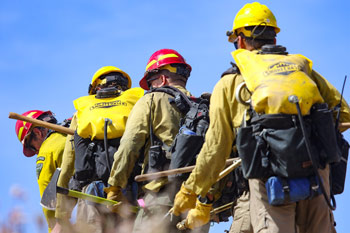Click Here for California Fires
August 19, 2024 - Right now, 62 large active wildfires are being managed with full suppression strategies nationwide. Current wildfires have burned 2,237,578 acres.  22,235 wildland firefighters and support personnel are assigned to wildfires, including 22 complex and 5 Type 1 incident management teams, 514 crews, 997 engines, 127 helicopters, and four Modular Airborne Fire Fighting Systems, or MAFFS.
22,235 wildland firefighters and support personnel are assigned to wildfires, including 22 complex and 5 Type 1 incident management teams, 514 crews, 997 engines, 127 helicopters, and four Modular Airborne Fire Fighting Systems, or MAFFS.
Sixty fireline management personnel from Australia and New Zealand are assigned to support large fires in the Northwest Area. For more information about the mobilization of wildland firefighters from Australia and New Zealand visit the international support page.
Two hundred forty-five soldiers from the 14th Brigade Engineer Battalion and the 1st Battalion, 17th Infantry Regiment based out of Joint Base Lewis McChord (JBLM) are deployed in support of wildland fire operations on the Boise National Forest. NIMO (Team 2) is assigned to support the military contingent. To learn more about military mobilizations, visit the military support page.
In the 21st century, we have seen hotter and more destructive wildfires. These blazes result from a mix of conditions. Build-up of fuels such as dead trees and brush combines with drought and extreme heat, exacerbated by climate change, creating a tinderbox ready to burn. There's only so much we can do about the weather, but we can do our part to be fire wise while recreating, traveling, or enjoying our homes. Take the time to find out the weather conditions and fire danger where you live and plan to vacation. Get the information you need about current wildland fire danger and be prepared. Start here: https://www.predictiveservices.nifc.gov/fuels_fire-danger/fuels_fire-danger.htm
There are fuels and fire behavior advisories in place for Northwest Texas, Colorado's Front Range and Eastern Wyoming, Southwest Oregon, the region east of the Cascades in Oregon and Washington, and California. Residents, travelers, or workers on their way to any of these states should be advised and familiarize themselves with the elevated risks.
Note: The current reporting from source data for year-to-date figures appears to be underreporting fire acreage in some geographic areas affecting the overall national statistics. Given the very high tempo and scale of national current fire activity, there will be delays in reconciling, especially from areas with large fires and dynamic fire activity. Adjustments may occur as the accuracy of fire locations, mapping and final fire reporting is reconciled.
Breezy southwesterly sustained winds of 12-25 mph with gusts 25-40 mph amid relative of 5-15% will develop along the Sierra Front into much of central Nevada. Lighter winds of 10-15 mph will occur in eastern Oregon to southwest Idaho, but low relative humidity of 5-20% is likely to continue with fair to poor overnight recovery. Isolated mixed wet and dry thunderstorms will develop in far eastern Nevada into east-central Idaho and southwest/central Montana on the fringe of the monsoon moisture plume. To the east, scattered wet thunderstorms will develop across much of Arizona, Utah, western Wyoming, West Slope, and far western New Mexico. Hot temperatures of 95-110°F will continue across New Mexico, east of the Divide, into the southern Plains and Lower Mississippi Valley. Hot and dry conditions are likely to spread into southeast Colorado, as well. Minimum relative humidity will fall to 10-25% in the Plains and New Mexico, and 30-45% in East Texas to Mississippi. Isolated to scattered mainly wet thunderstorms will develop in southeast Arkansas, Mississippi, and Alabama during the evening along a southward moving cold front, with more widespread showers and thunderstorms developing overnight in eastern Oklahoma and western Arkansas. Scattered to widespread wetting rain is also forecast from the Appalachians to the East Coast ahead of the cold front. National Predictive Services Outlook 6 Minutes for Safety: The 6 Minutes for Safety topic of the day is Transfer of Command.
| Number of new large fires or emergency response * New fires are identified with an asterisk |
4 | States currently reporting large fires: |
| Total number of active large fires Total does not include individual fires within complexes. |
53 | |
| Acres from active fires | 1,183,982 | |
| Fires contained | 2 |
Year-to-date statistics
| 2024 (1/1/24-8/19/24) | Fires: 30,445 | Acres: 5,486,044 |
| 2023 (1/1/23-8/19/23) | Fires: 36,146 | Acres: 1,751,041 |
| 2022 (1/1/22-8/19/22) | Fires: 21,181 | Acres: 5,964,523 |
| 2021 (1/1/21-8/19/21) | Fires: 40,945 | Acres: 4,399,923 |
| 2020 (1/1/20-8/19/20) | Fires: 37,569 | Acres: 2,747,015 |
| 2019 (1/1/19-8/19/19) | Fires: 30,734 | Acres: 3,767,941 |
| 2018 (1/1/18-8/19/18) | Fires: 41,316 | Acres: 5,898,147 |
| 2017 (1/1/17-8/19/17) | Fires: 42,665 | Acres: 6,419,642 |
| 2016 (1/1/16-8/19/16) | Fires: 38,504 | Acres: 4,091,134 |
| 2015 (1/1/15-8/19/15) | Fires: 41,337 | Acres: 7,210,959 |
| 2014 (1/1/14-8/19/14) | Fires: 37,010 | Acres: 2,625,499 |
10-year average Year-to-Date
| 2014-2023 | Fires: 38,500 | Acres: 4,374,886 |
Source: NIFC








